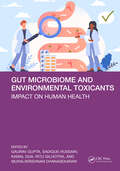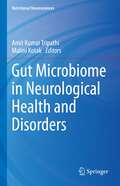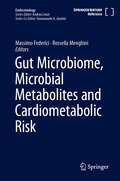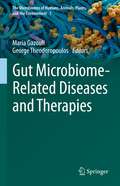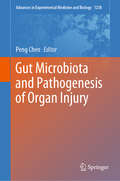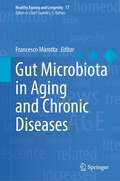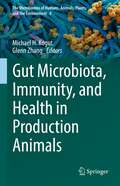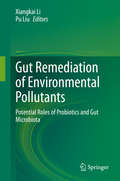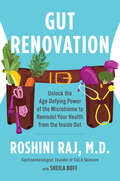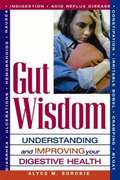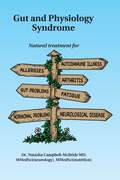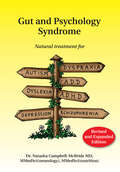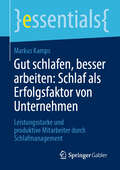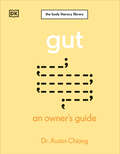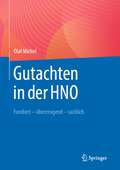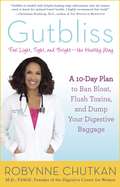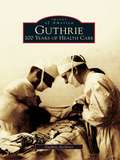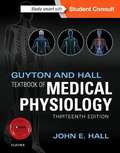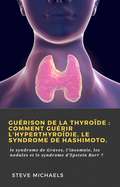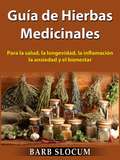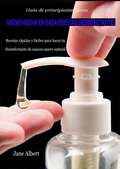- Table View
- List View
Gut Microbiome and Environmental Toxicants: Impact on Human Health
by Gaurav Gupta, Md Sadique Hussain, Kamal Dua, Ritu Gilhotra, and Murali DhanasekaranThis book comprehensively reviews the intricate relationship between environmental toxicants and the gut microbiome. It explores the role of dietary choices and lifestyle in shaping and modulating the gut microbiome’s response to environmental toxicants. It examines the intricate relationship between these toxic substances and the composition, function, and overall health implications of the gut microbiome. The chapters provide in-depth insights into the impacts of various toxicants, such as phthalates, pesticides, organic pollutants, bisphenols, and heavy metals, on the delicate microbial balance within our digestive systems. Specific chapters address the impact of lead, mercury, cadmium, and arsenic on the composition and function of the gut microbiome. The book concludes by addressing future prospects and challenges in understanding and mitigating the impacts of environmental toxicants on the gut microbiome and highlighting the importance of these efforts.Key Features: Provides a comprehensive examination of the intricate relationship between environmental toxicants and the gut microbiome Reviews the possible mechanisms underlying bidirectional interactions between environmental pollutants and GI Examines the role of dietary choices and lifestyle factors in modulating the gut microbiome's response to environmental toxicants Covers the impact of toxic substances, phthalates, pesticides, and heavy metals on the gut microbiome Explores the practical implications of toxicant exposure on human health This book is intended for researchers and scientists working in the fields of environmental toxicology, microbiology, pharmacology, and related disciplines.
Gut Microbiome in Neurological Health and Disorders (Nutritional Neurosciences)
by Amit Kumar Tripathi Malini KotakThis book provides an overview of bidirectional communication between gut-microbiome-brain, pathways, nutrients, and metabolites that are involved in microbiota gut-brain axis (MGBA) interactions. Further it reviews the relevance of this axis in the neurological disorders and potential therapeutic interventions, involving gut microbiome or probiotics and prebiotics which can ameliorate the neurological disorders. The book examines the role of gut microbiota in the establishment and hemostasis of innate immune response and explores the possibility of development of microbiome-targeted therapeutic interventions. Notably, the book discusses the role of the gut microbiota and immune system on the maintenance of brain functions and the development of neurological disorders. It also highlights the recent advances in improving neurological diseases by phytochemicals, prebiotics and probiotics. This book is useful for researchers working in neuropharmacology, Clinical Research, toxicology, neurodegeneration, and stroke biology.
Gut Microbiome, Microbial Metabolites and Cardiometabolic Risk (Endocrinology)
by Massimo Federici Rossella MenghiniThis reference work is strong informative about the role of the gut microbiome in organism metabolism and fully discusses the relationship between gut alterations and/or gut microbiome-derived metabolites and the pathogenesis of many diseases, as well as recent advances in clinical applications of microbiome and microbial effector molecules.It clearly shows how the microbiome research is a growing field in molecular and clinical sciences, due to technical advances based on high throughput genetic sequencing technologies and omics analyses that empower systems biology-based methods for precision health monitoring and treatment. It will help in understanding that high diversity of the microbial communities in the gut is important to preserve health and microbiome alterations, not only in nutrition associated diseases like obesity and diabetes, but also in many chronic inflammatory, cardiovascular, oncological and neurological disorders. Written by renown experts in the field, this reference work is intended for clinicians, residents, specialists and physicians involved in the diagnosis and treatment of affected patients. It is published as part of the SpringerReference program, which provides access to live editions constantly updated through a dynamic peer-review publishing process.
Gut Microbiome-Related Diseases and Therapies (The Microbiomes of Humans, Animals, Plants, and the Environment #1)
by Maria Gazouli George TheodoropoulosThis book reviews recent knowledge of the role of gut microbiome in health and disease. It covers extensive topics for several diseases, including metabolic-related diseases, allergies, gastrointestinal diseases, psychiatric diseases, and cancer, while also discussing therapeutic approaches by microbiota modification. Comprehensive and cutting-edge, Gut Microbiome-Related Diseases and Therapies deepens a reader’s theoretical expertise in gut microbiome.Graduate and postdoctoral students, medical doctors, and biomedical researchers will benefit from this book.
Gut Microbiota and Pathogenesis of Organ Injury (Advances in Experimental Medicine and Biology #1238)
by Peng ChenThis book aims to introduce the latest research in gut microbiota by systematically summarizing how it modulates the pathogenesis of organ injury including alimentary tract injury, liver injury, lung injury, brain injury, renal injury, heart and vascular injury, endocrine disorders, immune responses and multiple organ dysfunction syndrome (MODS) during sepsis. Gut microbiota which is recognized as a new “organ” in the body has been demonstrated to be able to regulate the homeostasis of many organs. The key role played by gut microbiota is the hotspot in biomedical research nowadays. This book provides a state-of-the-art report on recent discoveries regarding the novel insight into the mechanisms of human diseases progression. It will also offer the overall picture of the pathophysiologic roles of gut microbiota. This book is helpful for graduate students and professional researchers to get the knowledge of frontiers in both gut microbiota and organ injury.
Gut Microbiota in Aging and Chronic Diseases (Healthy Ageing and Longevity #17)
by Francesco MarottaThis edited volume studies gut microbiota peculiarities in elderly, in senescence-related and environmental-related alterations of gut microbiota in chronic diseases. Aging, as a physiological process mediated through several regulatory pathways and transcription factors, is generally speaking associated to a relentless functional decline and increasing risk of chronic diseases. Growing data on gut microbiota quali-quantitative changes in aging gut, and the opportunity to study by advanced NGS and metabolomic technologies, now offers novel horizons to link such changes to disease risks and to theoretically the weapons for gut microbiota intervention as an effective therapeutic tool. Chapters are divided into clear sections, starting with the aging perspective, then moving from chronic diseases to neurodegenerative diseases and cancer. The final parts focusses on interventions. Contributors are well-reputed and dedicated scientists in clinics and experimental medicine from 4 different continents who have provided their contribution keeping the polar star on aging as a guide while investigating their gut microbiota in occurrence and progression of disease together with proposed preventing, monitoring and therapeutic interventions. In the wide offer of books on gut microbiota, this age-thematic volume will be a valuable source of updated information for a wide group of readership including gerontologists, geriatricians, medical specialists of several fields, PhDs, basic scientists and public/private research entities focused on potential intervention in and through gut ecosystem. This book will stimulate a large number of basic scientists and clinicians to review their once organ (or cellular line)-specific knowledge and widen either their pathophysiological mechanisms understanding while providing novel ways to prevent, monitor and treat diseases from eyes to bones.
Gut Microbiota, Immunity, and Health in Production Animals (The Microbiomes of Humans, Animals, Plants, and the Environment #4)
by Michael H. Kogut Glenn ZhangThis work sheds new light on the interplay between the gut, gut microbiota, and host physiological processes in production animals.The gut microbiome shapes health and susceptibility to disease and has become a leading area of research in the animal sciences. Gut health encompasses a number of physiological and functional features. Nutrient digestion and absorption, host metabolism and energy generation, a stable microbiome, mucus layer development, barrier function, and mucosal immune responses; all of which are required to interact to make an animal perform physiologically and according to its greatest genetic potential.This carefully presented book broadens our vision, approach and results on gut health and the ability to regulate animal production. Understanding the chemistry of microbiomes has broad implications, including providing functional annotations for the microbial genomes, insights into the chemical languages that link microbes to each other and to their host, and translational implications for precision veterinary medicine, environmental health, and sustainable animal agriculture and welfare. Experts working in microbiome research, host immunity, and animal production, veterinarians and researchers in livestock science will understand the great importance of this volume.
Gut Remediation of Environmental Pollutants: Potential Roles of Probiotics and Gut Microbiota
by Xiangkai Li Pu LiuThis book focuses on probiotics and gut microbiota, as well as their roles in alleviating the toxicity of various environmental pollutants, presenting the latest research findings and explaining advanced research methods and tools. At the same time, it offers suggestions for future research directions. Further, the book introduces readers to the concept of gut remediation, a potential approach to reducing environmental-pollutant toxicity in vivo, based on modulation of gut microbiota using probiotic supplements. Lastly it provides suggestions for further reading.
Gut Renovation: Unlock the Age-Defying Power of the Microbiome to Remodel Your Health from the Inside Out
by Dr. Roshini RajCombining the latest developments and research discoveries, board-certified gastroenterologist and medical host on CNN and Fox News, Dr. Roshini Raj shows the ways in which the microbiome impacts overall well-being, and helps readers reset their biological clocks by improving their gut health.With one in four Americans suffering from digestive health issues every day, gut health has become an increasingly important part of wellness. With the human body, so many issues can be improved upon, or cured, by balancing the microbiome. But the microbiome—a community of bacteria, viruses, and yeasts that dwell in the body—has long been something that the average person can find baffling—and maybe a little bit gross.By offering simple and straightforward answers to questions like what one should be eating, what probiotics are, which vitamins and medicines really work, Dr. Raj demystifies the gut. She uses the idea of a home renovation to show how different organs and parts of the body can be “renovated” in order to optimize the microbiome. After all, balancing one’s microbiome improves digestive health, brain function, emotional stability, the body’s response to inflammation, immunity, and lessens premature aging. Melding the latest developments and discoveries in microbiome research, along with Dr. Raj’s practical tips developed from her years of clinical experience, Gut Renovation shows readers how to turn back the biological clock and revamp the way they live forever.
Gut Wisdom: Understanding and Improving Your Digestive Health
by Alyce M. SorokieA positive mental attitude is everything, and this inspirational as well as informative guide to good tummy health is fairly brimming with it. Sorokie, who owns her own holistic health center in Chicago and teaches "gut wisdom" workshops, offers a complete instructional rundown, from diseases to diets, in her effort to make all people realize "your gut 'knows' what you need." She explains why not to ignore the signs and signals your gut is giving you about your digestive health and how not to ignore its messages--meaning, what to do about the information you are receiving, in terms of what to put into your mouth and what not to. Her user-friendly format permits easy consultation about a specific problem, and her warm tone encourages reading the book straight through, as a "journey," as the author calls it.
Gut and Physiology Syndrome: Natural Treatment for Allergies, Autoimmune Illness, Arthritis, Gut Problems, Fatigue, Hormonal Problems, Neurological Disease and More
by Dr. Natasha Campbell-McBride, M.D.The long-awaited companion volume to Gut & Psychology Syndrome, the book that launched the GAPS diet, which has been translated into 22 languages and sold more than 300,000 copies. Since the publication of the first GAPS book, Gut and Psychology Syndrome, in 2004, the GAPS concept has become a global phenomenon. People all over the world have been using the GAPS Nutritional Protocol for healing from physical and mental illnesses. The first GAPS book focused on learning disabilities and mental illness. This new book, Gut and Physiology Syndrome, focuses on the rest of the human body and completes the GAPS concept. Allergies, autoimmune illness, digestive problems, neurological and endocrine problems, asthma, eczema, chronic fatigue syndrome and fibromyalgia, psoriasis and chronic cystitis, arthritis and many other chronic degenerative illnesses are covered. Dr. Campbell-McBride believes that the link between physical and mental health, the food and drink that we take, and the condition of our digestive system is absolute. The clinical experience of many holistic doctors supports this position.
Gut and Psychology Syndrome: Natural Treatment for Autism, Dyspraxia, A.D.D., Dyslexia, A.D.H.D., Depression, Schizophrenia, 2nd Edition
by Natasha Campbell-Mcbride MDDr. Natasha Campbell-McBride set up The Cambridge Nutrition Clinic in 1998. As a parent of a child diagnosed with learning disabilities, she is acutely aware of the difficulties facing other parents like her, and she has devoted much of her time to helping these families. She realized that nutrition played a critical role in helping children and adults to overcome their disabilities, and has pioneered the use of probiotics in this field. Her willingness to share her knowledge has resulted in her contributing to many publications, as well as presenting at numerous seminars and conferences on the subjects of learning disabilities and digestive disorders. Her book Gut and Psychology Syndrome captures her experience and knowledge, incorporating her most recent work. She believes that the link between learning disabilities, the food and drink that we take, and the condition of our digestive system is absolute, and the results of her work have supported her position on this subject. In her clinic, parents discuss all aspects of their child&’s condition, confident in the knowledge that they are not only talking to a professional but to a parent who has lived their experience. Her deep understanding of the challenges they face puts her advice in a class of its own.
Gut schlafen, besser arbeiten: Leistungsstarke und produktive Mitarbeiter durch Schlafmanagement (essentials)
by Markus KampsDieses essential beleuchtet die entscheidende Rolle, die Schlaf bezüglich der Leistungsfähigkeit von Mitarbeitenden einnimmt, und zeigt, wie Verantwortliche eine gesunde Schlafkultur als Schlüsselfaktor für unternehmerischen Erfolg etablieren können. Zahlreiche Studien zeigen die Zusammenhänge zwischen Schlaf und Leistungsstärke auf und wie sich erholsamer Schlaf auf Wohlbefinden, Produktivität sowie Kreativität auswirken kann – ein bislang völlig unterschätzter Faktor in der Unternehmensführung. Unternehmenslenker und Verantwortliche im Betrieblichen Gesundheitsmanagement müssen diesen Kontext erkennen und wirksame Strategien und Maßnahmen entwickeln, die die Schlafgesundheit von Mitarbeitenden fördern. Der Autor liefert dazu konkrete Handlungsempfehlungen und zeigt auf, wie Unternehmen Schritt für Schritt ein nachhaltiges Schlafmanagement für ihre Mitarbeitenden entwickeln können – um damit dem Unternehmen zu mehr Erfolg zu verhelfen.
Gut: An Owner's Guide (The Body Literacy Library)
by Austin ChiangBecome body literate with Gut: An Owner's Guide, the next book in The Body Literacy Library, an enlightening series that will democratize health for a new generation of readers.Gut: An Owner's Guide is an informative, practical, and engaging introduction to this hidden-away part of the body. We tend only to pay attention to our gut when it tries to tell us something - when it feels uncomfortable or something goes wrong. This myth-busting book focuses on all aspects of gut health so you can steer clear of Dr Google and discover what will make your gut happier and healthier.Dr Austin Chiang is a world-renowned expert in gut health and TikTok star who believes everyone has a right to know and understand their body. He translates medical jargon into simple, clear prose, answering frequently asked patient queries and investigating what we fear and most misunderstand about our gut.In this book, you can find:-Easy-to-follow science and lifestyle advice with simple FAQs-Illustrations with data-driven images that show how certain lifestyle choices impact your health-Best tips to help you know how to best care for your body and gut-Chapters that outline how your gut works, How to have a healthy gut, and what to do to improve gut healthFrom what you should eat (or not) to how often you should poo, to the microbiome and the brain/gut connection - this taboo-tackling book applies science to every day, with simple illustrations, checklists, FAQs, and myth busters, all supported by the latest medical research. Gut: An Owner's Guide won't just help you understand your body; it might even change your life. This book is part of a series titled Breasts: An Owner's Guide by Dr Philippa Kaye, Brain: An Owner's Guide by Dr. Eli Ricker, and Heart: An Owner's Guide by Dr Paddy Barratt.
Gutachten in der HNO: Fundiert - überzeugend - sachlich
by Olaf MichelEine solide Gutachtentätigkeit basiert auf profunder medizinischer Sachkenntnis und neutraler, ausgewogener, wissenschaftlich begründeter Argumentation. Diese umfassende Nachschlagewerk beinhaltet alle Aspekte für die Gutachtenerstellung im HNO-Fachgebiet. Es wendet sich an alle Ärztinnen und Ärzte, die mit der Gutachtertätigkeit beginnen wollen, aber auch an bereits erfahrene Gutachter, die einen Überblick über Literatur, rechtliche Zusammenhänge u.a. suchen. Aus der Praxis: Zahlreiche Beispiele aus der langjährigen Gutachtenpraxis des Autors, Gerichtsurteile, aktuelle Rechtsprechung zum Zitieren, Berücksichtigung der neuesten Leitlinien, Empfehlungen, Verordnungen und Gesetze. Zum Nachschlagen: Formulierungsvorschläge, Querverweise auf Literaturdatenbanken und Originalquellen, Literaturverzeichnis mit DOI und Links zur Einsicht der OriginaltexteFür Zustands- und Zusammenhangsgutachten bis zum umfangreichen freien Gerichtsgutachten mit Sachverständigenanhörung in allen Rechtsgebieten geeignet.
Gutbliss
by Robynne ChutkanA renowned physician shares her complete 10-day digestive tune-up for women, with important revelations about good gastrointestinal health. Many so-called cures for women's bloating and indigestion, from juice cleanses to specialty diets, are based on junk science. For women seeking true relief from that overall feeling of discomfort in any size jeans, Dr. Robynne Chutkan has the perfect plan for feeling light, tight, and bright in ten days. Gutbliss offers: A primer on the real reasons for gastrointestinal distress, and why it's much more common in women A look at the debilitating side effects of supposedly healthy habits--from Greek yogurt to bloat-inducing aspirin An expert analysis of symptoms that could indicate a serious underlying condition An indispensable checklist to pinpoint the exact cause of your bloating Just a few small changes in diet, lifestyle, and exercise can make a huge difference in a woman's digestive health, but the changes have to be the right ones. Going beyond the basics of top sellers such as Wheat Belly, Dr. Chutkan's Gutbliss empowers women to take control of their gastrointestinal wellness.
Gute Kinderschutzverfahren: Tatsachenwissenschaftliche Grundlagen, rechtlicher Rahmen und Kooperation im familiengerichtlichen Verfahren
by Heinz Kindler Jörg M. Fegert Ulrike Hoffmann Thomas Meysen Katrin Chauviré-Geib Eva SchumannIn Kinderschutzfällen ist es Aufgabe der Jugendämter und Familiengerichte, im Raum stehende Kindeswohlgefährdungen einzuschätzen und gegebenenfalls durch geeignete Hilfen und Maßnahmen abzuwenden. Diese Einschätzungen und Entscheidungen können den weiteren Lebensweg von Kindern und ihren Eltern stark beeinträchtigen. Umso wichtiger ist es, dass die an familiengerichtlichen Kinderschutzverfahren beteiligten professionellen Akteure sich über ihre eigenen Aufgaben und die der anderen im Klaren sind, damit sie gut zusammenarbeiten können.Das vorliegende Buch vermittelt Grundlagenwissen aus verschiedenen Disziplinen und bietet damit das Fundament für eine gute interdisziplinäre Zusammenarbeit. Es enthält tatsachenwissenschaftliche Erkenntnisse zu Kindeswohlgefährdungen und deren Abwendung Grundlagenwissen zur kindlichen EntwicklungOrientierung zu den beteiligten Akteuren, Vernetzung und Interdisziplinarität Kenntnisse über die rechtlichen Rahmenbedingungen Grundzüge zum Ablauf von KinderschutzverfahrenDie Publikation orientiert sich am interdisziplinären Online-Kurs „Gute Kinderschutzverfahren“ (https://guteverfahren.elearning-kinderschutz.de/) und bietet allen juristischen, sozialpädagogischen, psychologischen und medizinischen Fachkräften die für qualifizierte Kinderschutzverfahren benötigten vertieften Grundlagenkenntnisse. Es handelt sich um eine Open-Access-Publikation mit freiem und uneingeschränktem Zugang zur elektronischen Ausgabe.
Guter Sex dank Selbsthypnose: So behandeln Sie Ihre sexuellen Probleme
by Barbara LaimböckFalls Sex ein Thema in Ihrem Leben ist – sei es, weil er zu oft, zu selten, gehemmt, schmerzhaft oder unbefriedigend, monoton oder exzentrisch oder gar nicht stattfindet – dann lesen Sie einfach dieses Buch. Viele Menschen beschäftigen Fragen wie diese: War ich gut? Was hält sie/er von mir? Bin ich ein guter Liebhaber? War der Orgasmus echt? Oh nein, nicht schon wieder! Hoffentlich klappt es heute! Wenn ich nur nicht wieder so schnell komme! Wie sag ich ihr/ihm, dass ich keine Lust habe? In diesem Selbsthilferatgeber hat die Sexualtherapeutin Dr. med. Barbara Laimböck Erfahrungen und Interventionen von 30 Jahren ärztlicher Tätigkeit mit Hypnosetherapie gesammelt. Sie erzählt Ihnen dazu Fallgeschichten, die therapeutische Wirkung erzielen. Auch Paarübungen stehen zur Verfügung. Probieren Sie es einfach aus und überraschen Sie die/den Partner*in. Aus dem Inhalt: Seriöse Informationen, Trance-Geschichten zum Direkt-Anhören, Einzel- und Paarübungen. Über die Autorin: Dr. med. Barbara Laimböck ist u.a. Ärztin für Allgemeinmedizin und psychotherapeutische Medizin, für KIP und Hypnose nach Milton Erickson. Immer schon hat sie alles Tabuisierte und Geheimnisvolle interessiert: der Körper des Menschen, sein komplexes Denken und Fühlen und insbesondere Sexualität. Ihre Erfahrungen in mehr als 30 Jahren Sexualtherapie stellt sie in diesem Ratgeber zur Verfügung.
Guthrie: 100 Years of Health Care
by Guthrie ArchivesWhen Dr. Donald Guthrie arrived in Sayre in 1910, it was home to the third-largest railroad repair shop in the world. A small hospital, the first in the region, had opened 25 years earlier to care for those injured in this dangerous work. Fresh from surgical training at the Mayo Clinic, Guthrie brought with him a vision and the energy and charisma to make his dream a reality. He started Guthrie Clinic, one of the oldest multispecialty group practices in the nation, and established Robert Packer Hospital as the region's premier destination for hospital care. Guthrie's reputation as a surgeon grew, and the hospital cared for leaders of business, government, and society alongside the townspeople. Through two world wars, the Great Depression, and a devastating fire-in which no lives were lost-nothing slowed Guthrie's vision, and it has become a lasting legacy. More than 200 photographs tell the remarkable story of the transformation of a small rural hospital into an award-winning integrated health care system.
Guyton And Hall Textbook Of Medical Physiology
by John E. HallThe 13th edition of Guyton and Hall Textbook of Medical Physiology continues this bestselling title's long tradition as the world's foremost medical physiology textbook. Unlike other textbooks on this topic, this clear and comprehensive guide has a consistent, single-author voice and focuses on the content most relevant to clinical and pre-clinical students. The detailed but lucid text is complemented by didactic illustrations that summarize key concepts in physiology and pathophysiology. Larger font size emphasizes core information around how the body must maintain homeostasis in order to remain healthy, while supporting information and examples are detailed in smaller font and highlighted in pale blue. Summary figures and tables help quickly convey key processes covered in the text. Bold full-color drawings and diagrams. Short, easy-to-read, masterfully edited chapters and a user-friendly full-color design.
Guérir les douleurs émotionnelles et physiques grâce au pouvoir de la méditation
by Pauline LawsonAimeriez-vous pouvoir éliminer les malaises, les inflammations, les reflux, la dépression, l'anxiété et la douleur ? Depuis très longtemps, la guérison naturelle par les techniques de méditation est utilisée pour traiter un certain nombre de maux ! L'utilisation des techniques de guérison naturelle par la méditation vous aidera également à traiter les maladies chroniques, les inflammations, votre système immunitaire, vos niveaux d'énergie, votre concentration, votre bonheur général, et bien plus encore ! Ressentez des émotions plus positives. Découvrez les secrets que les professionnels de la guérison naturelle utilisent pour se sentir en meilleure santé que jamais ! Avec des décennies de stratégies testées, cet ebook vous montrera la manière la plus rapide et la plus efficace d'utiliser la méditation au profit de votre bien-être ! Vous apprendrez comment augmenter votre bien-être en seulement quelques semaines. Non seulement cela, mais vous améliorerez littéralement tous les aspects de votre vie. Vous voulez savoir comment les gens gèrent les maladies chroniques et les troubles physiques et mentaux ? Vous aussi, vous pouvez apprendre les secrets pour y parvenir, ce qui vous permettra d'être plus heureux et en meilleure santé. Ce guide vous enseigne des techniques éprouvées sans avoir recours à des suppléments ou à des cours coûteux. Ce qui est inclus : - Remèdes. - Combattez le stress. - Avoir plus d'énergie. - Dormez mieux. - La pleine conscience. - Surmonter les maux. - La nutrition. - Ce que vous devez savoir. + BEAUCOUP PLUS ! Si vous voulez être en meilleure santé, guérir des maux, ou améliorer la concentration et le bien-être, alors ce guide est pour vous. --> Faites défiler vers le haut de la page et cliquez sur ajouter au panier pour acheter instantanément Avertisse
Guérison de la thyroïde: le syndrome de Graves, l'insomnie, les nodules et le syndrome d'Epstein Barr ?
by Doug FredrickAimeriez-vous être en mesure de faciliter l’élimination de l'hyperthyroïdie, du syndrome de hashimoto, du syndrome de Graves, de l'onsomnie, des malaises, des inflammations, des douleurs, de la dépression et de la douleur ? Depuis très longtemps, des techniques de guérison naturelles sont utilisées pour traiter un certain nombre de maux avec votre thyroïde et bien plus encore ! L'utilisation de techniques de guérison naturelles vous aidera également à lutter contre les maladies chroniques, les inflammations, votre système immunitaire, vos niveaux d'énergie, votre concentration, votre bonheur général, sans être exhaustif ! Découvrez les secrets que les professionnels de la médecine naturelle utilisent pour se sentir en meilleure santé plus que jamais ! Avec des décennies de stratégies testées, cet ebook vous montrera la façon la plus rapide et la plus efficace d'utiliser la guérison naturelle de votre thyroïde pour bénéficier de votre bien-être ! Vous apprendrez comment améliorer votre bien-être en quelques semaines seulement. En plus de cela, vous améliorerez littéralement tous les aspects de votre vie. Vous voulez savoir comment les gens gèrent les maladies et les affections chroniques ? Vous aussi, vous pouvez apprendre les secrets pour y parvenir, ce qui vous permettra d'être plus heureux et en meilleure santé. Ce guide vous enseigne des techniques éprouvées sans recourir à des suppléments ou à des cours coûteux. Sont inclus : - Remèdes. - Vaincre l'hyperthyroïdie. - Vaincre le syndrome d'Hashimoto. - Vaincre le syndrome de Graves. - Avoir plus d'énergie. - Améliorer le sommeil. - Vaincre les maux. - La nutrition. - Ce que vous devez savoir. + ET BIEN PLUS ENCORE ! Si vous voulez être en meilleure santé, guérir des maladies ou améliorer votre concentration et votre bien-être, ce guide est fait pour vous.
Guía Del Cuidado de la Piel para Mujeres
by Laurie LarsonPreferiría enfocarme en las medidas preventivas así como a la transparencia en cuanto a la belleza. Mi enfoque principal es el empoderamiento del consumidor. Se centra en mantener una conexión con mis “Consumidores en cuidado de la piel” que son proactivos y piden información así como validación antes de hacer sus compras. Considerando esto, mi enfoque es redefinir la belleza desde el punto de vista educativo, equipándolo con todos los pasos, herramientas y consejos para ayudarle a conseguir sus objetivos de salud y cuidado de la piel.
Guía de Hierbas Medicinales: Para la salud, la longevidad, la inflamación, la ansiedad y el bienestar
by Barb SlocumGuía de Hierbas Medicinales: Para la salud, la longevidad, la inflamación, la ansiedad y el bienestar por Bard Slocum Curar heridas, calmar dolores y molestias, curar la digestión lenta, perder peso y reducir el estrés. ¡Manténgase saludable! Estos son sólo algunos de los remedios herbales que se tratarán en este libro. Barb Slocum le muestra lo simple que es hacer remedios usando simples hierbas medicinales. Guía de Hierbas Medicinales: Para la salud, la longevidad, la inflamación, la ansiedad y el bienestar Curar heridas, calmar dolores y molestias, curar la digestión lenta, perder peso y reducir el estrés. ¡Manténgase saludable! Estos son sólo algunos de los remedios herbales que se tratarán en este libro. Barb Slocum le muestra lo simple que es hacer remedios herbales usando plantas simples y fácilmente disponibles. Estas mezclas son seguras y se ha comprobado que curan múltiples dolencias de manera segura. Reemplace sus medicamentos con hierbas naturales, menos adictivas, y curativas como una alternativa más barata y de bajo costo a la curación. Descargo de responsabilidad: Esta guía debe utilizarse únicamente como referencia. Si usted tiene alguna condición preexistente, debe consultar a un profesional médico antes de usar cualquiera de los remedios herbales que contiene. >>> Haga clic arriba para comprar al instante!
Guía de principiantes para Mano hecha en casa Recetas Desinfectantes: Recetas rápidas y fáciles para hacer tu Desinfectante de manos casero natural
by Jane AlbertEl desinfectante de manos commercial se está volviendo caro, y con la escasez de desinfectantes debido al COVID-19, es posible que debas recurrir a hacer el tuyo. Hacer tu propio desinfectante de manos es un proceso simple que resulta en una fórmula que puedes personalizar para satisfacer tus propios gustos. Los CCE (Centros de Control de Enfermedades) recomiendan lavarse las manos durante al menos 20 segundos varias veces al día, pero la realidad de la vida puede interponerse (en el camino, en un avión, tren o metro, entiendes el punto), y eso es cuando un desinfectante de manos es necesario. Si bien hay varias versiones de desinfectantes de manos sin alcohol en el mercado, los CCE recomiendan uno que contenga al menos 60% de alcohol para una máxima eficacia, y todos se venden en tiendas locales (al menos en Los Angeles) o por 10-20 veces su precio normal. Algnos desinfectantes de manos comerciales contienen ingredientes tan temibles como los gérmes de los que nos protegen, entonces, ¿por qué no hacer tu propio desinfectante de manos con los ingredientes que selecciones en unos pocos sencillos pasos? Aquí tienes una vista de lo que aprenderás: •Asuntos de Seguridad de los Desinfectantes para Manos •Efectividad de los Desinfectantes de Manos •Varias Recetas de Desinfectantes de Manos Caseros •Receta de la Organizacion Mundial de la Salud (OMS) para crearlo a base de alcohol para frotar •Como hacer Gel de Aloe Vera •Técnica Correcta de Lavado de Manos •Consejos del Uso Mas Eficiente de Desinfectante de Manos •!Y mucho más! Desplazate hacia arriba y haz click en el botón de "Comprar Ahora con 1-Click" para obtener tu copia !ya!
